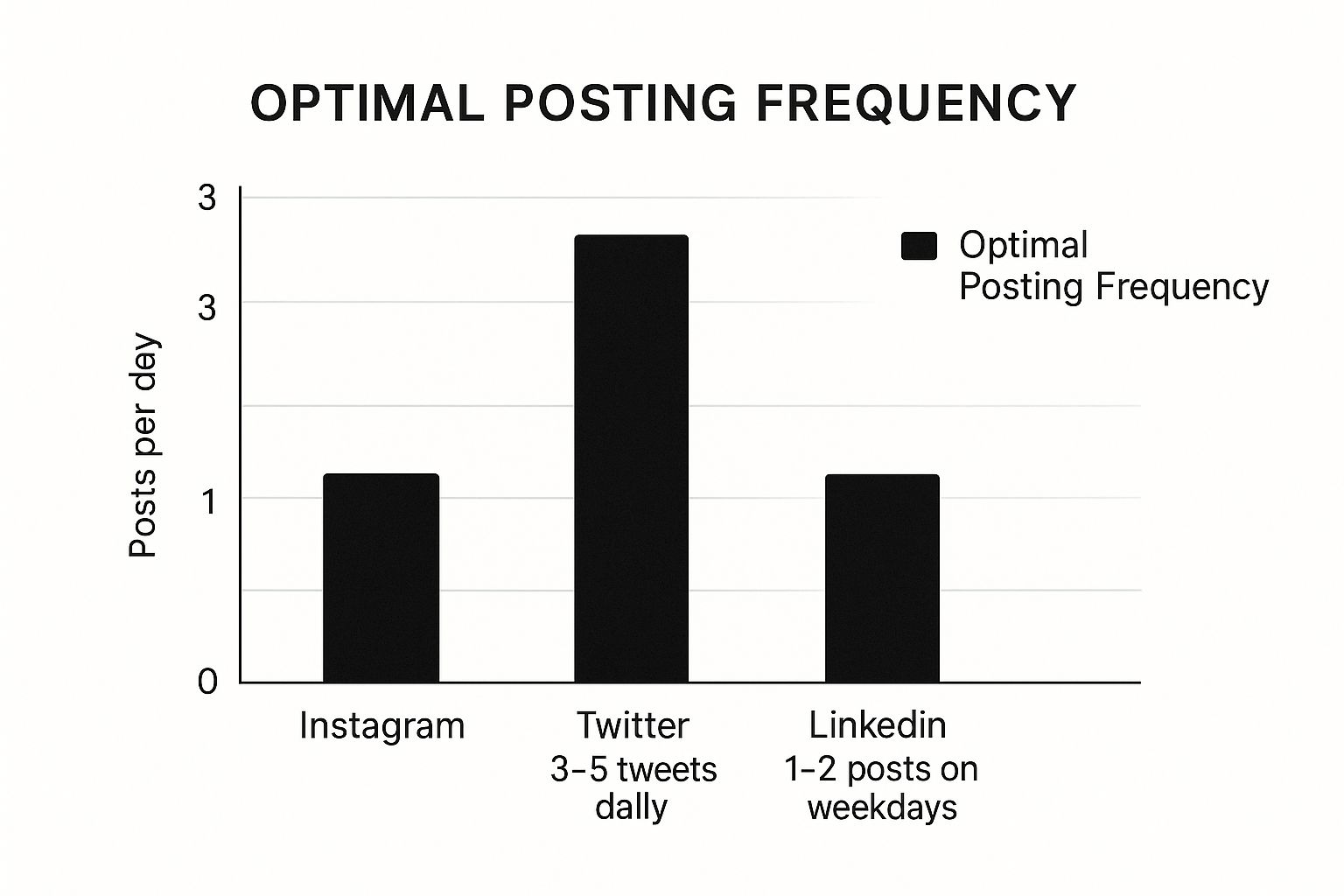Boost Your Strategy to Increase Social Media Engagement Today

Ready to Boost Your Social Media Game?
Want to increase social media engagement and see real results? Stop simply posting and start cultivating a thriving online community. This listicle reveals seven proven strategies to boost your engagement in 2025. Learn how to leverage user-generated content, interactive posts, strategic timing, influencer partnerships, community management, platform optimization, and storytelling to transform passive followers into active participants. These techniques are crucial for building relationships, driving conversations, and achieving measurable growth across your social media channels.
1. User-Generated Content Campaigns
One of the most effective ways to increase social media engagement is through user-generated content (UGC) campaigns. This strategy involves encouraging your followers to create and share content related to your brand or products. By leveraging the authentic voice of your customers, you can build trust, expand your reach, and boost engagement with content that resonates deeply with audiences because it comes from their peers, not directly from your brand. This organic approach fosters a sense of community and provides valuable social proof, ultimately contributing to increased brand loyalty and, of course, higher engagement rates.

User-generated content campaigns typically involve several key features: contests and challenges that prompt user participation, hashtag campaigns to organize and track submissions, mechanisms for content curation and resharing, and community recognition and rewards systems. These features create a structured and engaging environment for users to participate and contribute.
Examples of Successful Implementation:
- GoPro's #HomePro challenge: During the pandemic, GoPro encouraged users to showcase their creativity with home videos, resulting in a surge of engaging content.
- Starbucks' #WhiteCupContest: This campaign invited customers to design artwork on Starbucks cups, generating massive participation and brand buzz.
- Adobe's #Adobe_Perspective campaign: Showcasing user-created designs highlighted the power and versatility of Adobe's software while fostering a creative community.
- Airbnb's use of user-submitted travel photography: Featuring authentic travel experiences across their platforms provides compelling social proof and inspires wanderlust.
When and Why to Use UGC Campaigns:
UGC campaigns are particularly effective when you're looking to:
- Build authenticity and trust: UGC provides genuine endorsements from real customers, which resonates more strongly than polished brand messaging.
- Reduce content creation costs: Leveraging your audience's creativity reduces the burden on your internal team and provides diverse content perspectives.
- Expand organic reach: Participants share their creations with their own networks, extending your brand's visibility beyond your existing followers.
- Foster a sense of community: UGC campaigns create a shared experience and a sense of belonging among your audience.
Pros:
- Builds authentic social proof and trust
- Significantly reduces content creation costs
- Extends organic reach through participants' networks
- Creates a sense of community and belonging
- Generates diverse content perspectives
Cons:
- Quality control can be challenging
- Potential for inappropriate or off-brand submissions
- Requires consistent monitoring and moderation
- May need incentives to drive participation
- Success depends on having an engaged audience base
Actionable Tips for Running a Successful UGC Campaign:
- Create clear submission guidelines and expectations: This ensures that the content aligns with your brand and avoids potential issues.
- Offer meaningful incentives that appeal to your target audience: Rewards can range from product discounts to exclusive experiences, motivating participation.
- Feature and celebrate participants regularly across platforms: Showcasing user contributions increases visibility and encourages further engagement.
- Make participation simple with minimal barriers: The easier it is to participate, the higher the likelihood of success.
- Develop a content rights policy that protects both users and your brand: Address usage rights and permissions upfront to avoid legal complications.
This strategy has been popularized by brands like Apple with their #ShotOniPhone campaign, Buffer's content strategy team, social media influencer marketing pioneer Daniel Wellington, and Tourism Australia's visitor-generated content strategy. By following these tips and learning from successful examples, you can leverage the power of user-generated content to significantly increase social media engagement and strengthen your brand community.
2. Interactive Content Integration
Interactive content integration is a powerful strategy to increase social media engagement by shifting from passive consumption to active participation. Unlike static posts that users simply scroll past, interactive content requires users to engage, respond, and contribute. This two-way communication fosters a sense of community, boosts brand loyalty, and signals to social media algorithms that your content is valuable, leading to increased visibility. This method involves incorporating elements like polls, quizzes, surveys, interactive videos, augmented reality (AR) experiences, and gamification components into your social media strategy. By encouraging user input, you gather valuable audience insights and create more memorable brand experiences.

This approach deserves a prominent place in any social media engagement strategy because it directly addresses the core challenge of capturing and retaining user attention in a crowded digital landscape. Features like in-platform tools such as Instagram polls and questions, integrated quiz and assessment functionality, and AR filters and experiences offer readily available options to start experimenting with interactive content. More sophisticated integrations, such as interactive storytelling elements and gamification components, can further elevate engagement levels.
Successful implementations of interactive content are abundant. Consider Netflix's Bandersnatch, an interactive film where viewers choose the storyline, demonstrating the power of choice-driven engagement. Spotify's annual Wrapped personalized experience, summarizing users' listening habits, showcases the effectiveness of data-driven interaction. IKEA's AR Place app, allowing users to virtually place furniture in their homes, highlights the practicality and utility that interactive content can offer. And, of course, BuzzFeed's highly shareable quiz content model has become a benchmark for driving viral engagement.
Pros:
- Dramatically higher engagement rates than static content
- Provides valuable audience insights and data
- Creates memorable brand experiences
- Improves algorithm visibility due to longer interaction times
- Encourages return visits and repeat engagement
Cons:
- Often requires more technical resources to develop
- Can be platform-specific, limiting cross-posting potential
- May need regular updates to maintain interest
- Some interactive features have accessibility limitations
- Higher production costs than standard content
Tips for Implementing Interactive Content:
- Start Simple: Begin with platform-native tools like Instagram polls and questions before investing in custom solutions.
- Intuitive Design: Keep interactions simple and intuitive for users.
- Mobile-First: Design for mobile-first experiences, as the majority of social media users access platforms via mobile devices.
- Data Collection: Use interactions to gather meaningful customer data for personalized marketing efforts.
- Testing is Key: Test different interaction types (polls, quizzes, AR filters, etc.) to identify what resonates best with your target audience.
When and Why to Use Interactive Content:
Interactive content is particularly effective when you aim to:
- Increase brand awareness: Unique interactive experiences create buzz and generate shareable content.
- Drive lead generation: Quizzes and surveys can be used to collect contact information in exchange for personalized results.
- Educate your audience: Interactive tutorials and explainers can make complex topics more engaging.
- Boost conversions: Interactive product demos and AR experiences can bridge the gap between online browsing and purchase.
Popularized by innovators like BuzzFeed's content team, Instagram with their Stories interactive features, Snapchat's AR lens creators, and Gary Vaynerchuk's emphasis on platform-native engagement, interactive content continues to evolve. Learn more about Interactive Content Integration and consider how these strategies can revitalize your approach to increasing social media engagement.
3. Strategic Content Timing and Frequency
Want to increase social media engagement without spending a dime on ads? Strategic content timing and frequency is a powerful method that focuses on optimizing when and how often you post based on audience behavior analysis. This involves identifying peak engagement windows, understanding platform-specific algorithms, and maintaining a consistent presence without overwhelming your followers, ultimately maximizing visibility and interaction opportunities. It's a crucial aspect of any successful social media strategy, allowing you to organically reach a wider audience and boost your content performance.

The infographic above visualizes data comparing engagement rates across different posting times and days of the week. The bar chart clearly shows that posting on Tuesdays and Wednesdays between 10 AM and 1 PM yields the highest engagement, while weekends generally see lower activity. This highlights the importance of tailoring your posting schedule to align with peak audience activity. As the infographic demonstrates, strategically timing your content can significantly impact its performance.
This approach utilizes several key features: data-driven posting schedules, platform-specific timing strategies, content calendar management systems, analytics-based optimization, and automated scheduling tools integration. Imagine having a system that tells you the precise moment your target audience is most likely to see and engage with your posts. That's the power of strategic content timing.
Pros:
- Maximizes organic reach without additional spend: Reach a wider audience without relying on paid advertising.
- Improves content performance metrics across platforms: See increased likes, shares, comments, and overall engagement.
- Creates audience anticipation and habit formation: Consistent posting builds anticipation and encourages regular interaction.
- Helps maintain consistent brand presence: Stay top-of-mind with your audience and reinforce brand recognition.
- Allows for workload management and content batching: Plan and schedule content in advance, streamlining your workflow.
Cons:
- Requires ongoing analysis and adaptation: Audience behavior and platform algorithms are constantly changing, requiring continuous monitoring and adjustments.
- Optimal times can shift as algorithms change: Stay updated on platform updates and be prepared to adapt your strategy accordingly.
- May require 24/7 content management for global brands: Reaching a global audience may necessitate round-the-clock content scheduling.
- Can create team burnout if scheduling is too aggressive: Avoid overwhelming your team with an overly demanding content calendar.
- Different content types may require different timing strategies: Experiment and analyze which timing works best for various content formats.
Examples of Successful Implementation:
- Wendy's leverages strategic timing with witty tweets during peak lunch hours, capitalizing on when people are thinking about food.
- National Geographic maintains a global content schedule carefully aligned to different time zones to maximize reach across international audiences.
- HubSpot uses a data-backed approach to B2B content timing, ensuring their content reaches decision-makers at the optimal times.
- Later Media's own feed demonstrates optimal Instagram timing, showcasing their expertise in the field.
Actionable Tips for Increasing Social Media Engagement:
- Analyze your specific audience's active hours: Don't just rely on industry benchmarks. Use platform analytics to understand when your followers are most active.
- Test posting at unconventional times: You might uncover untapped engagement opportunities outside of typical peak hours.
- Maintain consistent frequency rather than sporadic bursts of content: Regular posting builds anticipation and keeps your audience engaged.
- Use platform analytics to refine timing strategy quarterly: Regularly review your performance data and adjust your strategy accordingly.
- Consider cultural and seasonal factors that affect audience behavior: Holidays, events, and cultural nuances can impact when your audience is online.
This approach is particularly effective when you're looking to maximize organic reach, improve content performance, and build a strong online presence without relying heavily on paid advertising. It’s fundamental to long-term social media success. Influencers like Neil Patel and platforms like Buffer and Hootsuite have championed the importance of strategic content scheduling, further solidifying its value in the digital marketing landscape. You can Learn more about Strategic Content Timing and Frequency to further refine your strategy. By understanding and implementing these principles, you can significantly increase social media engagement and achieve your marketing goals.
4. Micro-Influencer Partnerships
Micro-influencer partnerships are a powerful strategy to increase social media engagement. This approach involves collaborating with influencers who have a smaller, highly engaged following (typically 1,000-100,000 followers) to promote your products or services. Unlike celebrity endorsements, micro-influencers cultivate authentic connections with their audience, fostering trust and driving higher engagement rates. This makes them a cost-effective solution for businesses looking to boost genuine interaction and reach a targeted audience.

This strategy deserves a place on this list because it offers a unique blend of targeted reach, authenticity, and affordability. Features such as niche audience targeting, higher engagement rates than macro-influencers, and diverse partnership structures (affiliate, sponsored, collaborative) make it an adaptable and effective method for increasing social media engagement. Micro-influencers create more authentic and relatable content that resonates with specific communities, often demonstrating a greater willingness to create detailed, product-focused content than their macro-influencer counterparts. This translates into genuine enthusiasm that followers pick up on, leading to increased trust and credibility.
Examples of Successful Implementation:
- Glossier: Built its brand through a community-first approach, seeding products with micro-influencers to generate organic buzz and user-generated content.
- Daniel Wellington: Employed a massive-scale micro-influencer strategy, gifting watches to thousands of individuals with engaged followings to create a widespread social media presence.
- Sperry: Developed a user-turned-influencer community program, empowering loyal customers to become brand advocates and share their experiences with their followers.
- ASOS: Created the ASOS Insiders program, featuring style-focused micro-influencers who curate looks and share fashion advice with their dedicated audiences.
Pros:
- Higher trust and credibility with targeted audiences.
- Lower cost per engagement than celebrity partnerships.
- More authentic content that resonates with specific communities.
- Greater willingness to create detailed, product-focused content.
- Ability to test multiple niches simultaneously.
Cons:
- Requires managing multiple relationships for scale.
- Less established measurement and reporting standards.
- More time-intensive to identify ideal partners.
- Potential for inconsistent brand messaging across partners.
- May need more guidance on content creation.
Actionable Tips for Leveraging Micro-Influencer Partnerships:
- Focus on engagement rates rather than follower counts: A smaller following with high engagement is more valuable than a large, inactive one.
- Look for authentic brand affinity before reaching out: Partnerships are most effective when the influencer genuinely loves your brand.
- Create clear but flexible content guidelines: Provide direction while allowing for creative freedom.
- Develop long-term relationships rather than one-off campaigns: Ongoing collaborations build stronger connections and deliver better results.
- Provide exclusive experiences or information, not just product: Give influencers something unique to share with their audience.
When and Why to Use This Approach:
Micro-influencer partnerships are ideal for businesses looking to:
- Increase brand awareness within a specific niche.
- Drive targeted traffic to their website or social media channels.
- Generate authentic user-generated content.
- Build trust and credibility with potential customers.
- Achieve a higher return on investment compared to macro-influencer or celebrity partnerships.
This approach is particularly effective for e-commerce brands, small businesses, and startups looking to establish a strong social media presence and connect with their target audience on a deeper level. By focusing on genuine engagement and building meaningful relationships, micro-influencer partnerships can significantly increase social media engagement and drive business growth.
5. Community Management and Response Strategy
Want to increase social media engagement? A robust community management and response strategy is crucial. This approach focuses on actively nurturing online communities through consistent and thoughtful interaction with your followers. It's more than just posting content; it's about building relationships, fostering dialogue, and creating a thriving online space where your audience feels valued and heard. This active participation transforms passive audiences into active participants and, ultimately, brand advocates, which directly contributes to increased social media engagement.
How it Works:
Community management involves several key components working in harmony:
- Rapid Response: Timely replies to comments and messages show your audience you're listening and care. This builds trust and encourages further interaction.
- Conversation Facilitation: Don't just broadcast; initiate conversations. Ask questions, create polls, and host Q&A sessions to spark discussions and keep your community active.
- Clear Guidelines and Moderation: Establish community guidelines to set expectations for behavior and ensure a safe and respectful environment. Active moderation keeps the conversation positive and productive.
- Crisis Management: Have a plan in place to address negative feedback and potential PR crises. Transparency and swift action are essential for mitigating damage and maintaining trust.
- Sentiment Analysis and Monitoring: Utilize tools to track brand mentions and analyze the overall sentiment surrounding your brand. This helps you understand audience perception and identify potential issues early on.
Examples of Success:
Several brands have mastered the art of community management to increase social media engagement:
- Glossier: Their customer-centric approach, built around genuine interaction and product feedback, has cultivated a fiercely loyal community.
- Airbnb: Their host forums and support systems foster a sense of belonging and provide valuable resources, leading to a thriving host community.
- Peloton: Motivational engagement strategies and a strong sense of community have been key to Peloton's success in building a dedicated following.
- Xbox: Their responsive and engaging community management on Twitter, particularly within the gaming community, has built a strong and loyal fanbase.
Actionable Tips for Increasing Social Media Engagement:
- Respond Promptly: Aim to respond to all comments and messages within the first hour whenever possible.
- Spark Conversations: Don't just make statements; ask questions and encourage dialogue.
- Address Negative Feedback: Acknowledge negative feedback publicly but resolve issues privately. This demonstrates transparency and a commitment to customer satisfaction.
- Develop a Consistent Voice: Create a personality and voice guide to ensure consistent communication across your team.
- Celebrate Your Community: Regularly acknowledge and celebrate community members to foster a sense of belonging and appreciation.
Pros and Cons:
Pros:
- Builds stronger emotional connections with your audience.
- Improves customer retention and loyalty.
- Generates valuable product feedback and insights.
- Creates algorithm advantages through high engagement signals, thus increasing visibility and reach.
- Transforms customers into brand advocates, amplifying your message organically.
Cons:
- Requires significant time and human resources.
- Can expose brands to public criticism.
- Demands consistent tone and voice across team members.
- Requires 24/7 monitoring for larger brands.
- Success metrics can be difficult to quantify.
Why This Strategy Deserves Its Place on the List:
In today's social media landscape, simply broadcasting your message isn't enough. Building a thriving online community is essential for increasing social media engagement. By actively engaging with your audience, fostering relationships, and creating a sense of belonging, you can transform passive followers into active participants and passionate brand advocates. This strategy, although resource-intensive, provides long-term benefits that far outweigh the challenges. It's an investment in building a loyal customer base and a strong brand reputation. Pioneered by figures like Richard Millington and exemplified by brands like Wendy's and Starbucks, community management has proven its power in driving organic growth and achieving significant social media success.
6. Platform-Specific Content Optimization
Want to increase social media engagement? Stop treating all platforms the same. Platform-Specific Content Optimization is a crucial strategy that recognizes the unique nature of each social media channel. Instead of cross-posting identical content, this approach involves tailoring content formats, styles, and messaging to resonate with the specific audience, technical capabilities, and algorithmic preferences of each platform. It's about working with the platform, not against it.
This method works by leveraging the strengths of each individual platform. For example, short-form, engaging video content thrives on TikTok, while polished, high-resolution imagery is key for Instagram. LinkedIn, being a professional networking site, demands thought-provoking articles and industry insights. By customizing your content, you're not just throwing content into the void; you're strategically placing it where it's most likely to be seen and engaged with by the right audience.
Successful examples of this strategy abound. Consider Chipotle's playful and trend-driven TikTok presence compared to their more polished and food-focused Instagram feed. Duolingo uses distinct brand personas tailored to each platform, amplifying their humorous and engaging content. Even established organizations like The Washington Post utilize a differentiated content strategy, recognizing the diverse audiences and expectations on platforms like Twitter versus their main website. Red Bull, a master of content marketing, goes so far as to have platform-specialized content teams, demonstrating a serious commitment to this approach.
Actionable Tips for Platform-Specific Content Optimization:
- Research is Key: Study top-performing native content on each platform before creating your own. Understand what resonates with the audience and what the platform's algorithm favors.
- Repurpose, Don't Duplicate: You can still leverage core content ideas across multiple platforms. Instead of duplicating content verbatim, repurpose it into formats suitable for each channel. A blog post could become a Twitter thread, an Instagram carousel, or even a short video for TikTok.
- Focus Your Efforts: Instead of spreading your resources thin across numerous platforms, invest more heavily in 2-3 primary platforms that align with your target audience.
- Stay Agile: Social media algorithms are constantly evolving. Update your platform strategies quarterly to keep up with the latest trends and best practices.
- Maintain Consistency: Develop platform-specific style guides to ensure a consistent brand voice across varied content formats.
Pros and Cons of Platform-Specific Content Optimization:
Pros:
- Significantly higher engagement rates than generic cross-posting
- Improved algorithm performance on each platform
- More authentic and engaging presence on each channel
- Ability to leverage platform-specific features and trends like Instagram Reels or LinkedIn Articles
- Effective reach of different audience segments
Cons:
- Requires more content creation resources and effort
- More complex content calendar management
- Needs platform-specific expertise for optimal performance on each channel
- Potentially higher production costs and time investment
- Demands maintaining a consistent brand voice across a variety of formats
Platform-Specific Content Optimization deserves its place on this list because it’s essential for maximizing your social media ROI. By tailoring your content to each platform, you’re not just posting, you’re connecting. You’re speaking directly to your target audience in the language they understand and on the platforms they prefer. This targeted approach leads to increased engagement, stronger brand recognition, and ultimately, better business outcomes. Learn more about Platform-Specific Content Optimization, particularly how to tailor your approach for LinkedIn. As Gary Vaynerchuk and other social media experts emphasize, respecting the unique characteristics of each platform is crucial for success in today's fragmented social media landscape. This concept is further validated by research from organizations like Social Media Examiner, and by the practices of platform leaders like TikTok creative director Sandie Hawkins and Instagram expert Sue B. Zimmerman.
7. Storytelling and Narrative-Driven Campaigns
In the quest to increase social media engagement, storytelling and narrative-driven campaigns have emerged as a powerful tool. This strategy moves beyond isolated posts and leverages cohesive narratives and emotional storytelling techniques to create compelling, multi-post campaigns that keep audiences invested and coming back for more. Instead of simply broadcasting information, narrative campaigns foster a sense of continuity and build deeper connections, offering a significant advantage in today's crowded social media landscape.
This approach deserves its place on this list because it addresses a fundamental aspect of human interaction: our inherent love for stories. By tapping into this innate desire, brands can create content that resonates on a deeper level, leading to increased engagement and a stronger sense of community.
How it Works:
Narrative-driven campaigns unfold like a story, with a beginning, middle, and end (or ongoing continuation). They often feature recurring characters, themes, or plot lines that develop over time across multiple posts. This creates a sense of anticipation and encourages followers to stay tuned for the next installment.
Features of Narrative Campaigns:
- Story arc development across multiple posts: A clear narrative arc with rising action, climax, and resolution (or ongoing development).
- Character or personality-driven content: Content centered around relatable characters or distinct brand personalities.
- Emotional triggers and connection points: Stories that evoke emotions like joy, sadness, excitement, or inspiration.
- Serialized content release strategies: Content released in installments to maintain audience interest and encourage anticipation.
- Cross-platform narrative extensions: Extending the narrative across different social media platforms for broader reach.
Pros:
- Creates stronger emotional bonds with the audience: Stories connect with audiences on a human level, fostering loyalty and affinity.
- Improves content memorability and brand recall: Narrative content is more memorable than standalone posts, boosting brand recognition.
- Encourages followers to return for story continuations: The serialized nature of the content incentivizes repeat engagement.
- Differentiates from transactional or promotional content: Storytelling stands out from the constant barrage of promotional messages.
- Provides framework for cohesive long-term content strategy: Narratives provide a structure for ongoing content creation.
Cons:
- Requires more advanced content planning: Developing a compelling narrative requires careful planning and strategizing.
- Success depends on consistent execution: Maintaining momentum and audience interest demands consistent posting.
- More difficult to measure direct conversion impact: The impact of storytelling is often less direct and harder to quantify than traditional advertising.
- Needs stronger creative direction than standard posts: Effective storytelling requires strong creative skills and vision.
- May not work for all brand categories: Some brands may find it challenging to adapt their message to a narrative format.
Examples of Successful Implementation:
- Airbnb's 'Belonging Anywhere' narrative campaign: Airbnb uses storytelling to showcase the power of connection and belonging through travel experiences.
- Nike's athlete journey storytelling approach: Nike tells inspiring stories of athletes overcoming challenges and achieving their goals.
- Dove's Real Beauty narrative evolution: Dove's long-running campaign challenges beauty standards and promotes self-acceptance through powerful stories.
- Spotify's data-driven personal storytelling in Wrapped: Spotify leverages user data to create personalized narratives about their listening habits.
Actionable Tips for Increasing Social Media Engagement with Storytelling:
- Focus on authentic human elements rather than product features: Highlight relatable human experiences and emotions.
- Create content calendars organized around narrative themes: Plan your content in advance to ensure a cohesive narrative flow.
- Use a mix of formats (video, images, text) to advance stories: Different formats cater to different audience preferences and can enhance the storytelling experience.
- Incorporate customer stories into brand narratives: User-generated content adds authenticity and builds community.
- Create serialized content with clear posting schedules: Maintain consistent posting to keep the audience engaged and anticipating the next installment.
Inspiration and Frameworks:
Storytelling expert Donald Miller's StoryBrand framework, Pixar's storytelling principles applied to marketing, Apple's narrative-focused product launches, and Instagram's sequential carousel format all provide valuable insights and inspiration for crafting compelling narrative-driven campaigns.
By embracing the power of storytelling, brands can forge deeper connections with their audience, increase social media engagement, and build a loyal community around their brand.
7 Strategies Engagement Comparison
| Strategy | Implementation Complexity 🔄 | Resource Requirements ⚡ | Expected Outcomes 📊 | Ideal Use Cases 💡 | Key Advantages ⭐ |
|---|---|---|---|---|---|
| User-Generated Content Campaigns | Moderate Needs monitoring & moderation |
Low to Moderate Incentives and curation |
Builds trust & social proof Expands organic reach |
Brands with engaged audience Community building |
Authentic content Cost-effective content creation |
| Interactive Content Integration | High Requires technical development & updates |
High Technical skills and platform tools |
Dramatically higher engagement Valuable audience insights |
Brands focusing on engagement & data collection | Memorable experiences Boosts algorithm visibility |
| Strategic Content Timing & Frequency | Moderate Requires continual analysis & adaptation |
Moderate Analytics tools & scheduling |
Maximizes organic reach Improves consistency |
Brands seeking optimized posting impact | Efficient reach Audience habit formation |
| Micro-Influencer Partnerships | Moderate to High Managing multiple partnerships |
Moderate Relationship management & outreach |
Higher targeted engagement Authentic niche content |
Brands targeting niche markets Cost-sensitive |
High trust Cost-effective influencer marketing |
| Community Management & Response | High Needs 24/7 monitoring & consistent voice |
High Dedicated community managers |
Strong emotional connections Improved retention |
Brands prioritizing customer loyalty & advocacy | Builds loyalty Generates feedback & insights |
| Platform-Specific Content Optimization | High Requires platform expertise and varied content |
High Content creation for each platform |
Higher engagement rates Algorithm advantage |
Brands active on multiple social platforms | Authentic platform presence Better audience targeting |
| Storytelling & Narrative-Driven Campaigns | Moderate to High Needs advanced planning & creativity |
Moderate to High Creative resources |
Strong emotional bonds Improved brand recall |
Brands building long-term audience relationships | Deep engagement Cohesive brand narratives |
Elevate Your Engagement Strategy Today
Increasing social media engagement is crucial for any successful online presence. This article has explored seven core strategies to achieve just that: leveraging user-generated content, integrating interactive elements, optimizing posting schedules, partnering with micro-influencers, implementing a robust community management strategy, tailoring content to each platform, and harnessing the power of storytelling. Mastering these approaches isn't just about boosting likes and comments; it's about fostering genuine connections, building brand loyalty, and ultimately driving business growth. By understanding your audience and consistently providing valuable, engaging content, you can transform your social media channels into thriving communities.
To further enhance your social media strategy and boost your results, check out these proven tips to increase social media engagement from OKZest's Top 10 Tips to Increase Social Media Engagement. These insights can provide additional strategies to refine your approach and maximize your impact. Remember, the key to increasing social media engagement lies in adapting and iterating based on data and feedback. Analyze what resonates with your audience, experiment with different formats, and never stop learning.
Want to streamline your content creation process, especially for visually-rich platforms? Explore how Lumeo can help you create stunning visuals and presentations, amplifying your brand message and captivating your audience, leading to increased engagement. Start elevating your social media strategy today and watch your online presence flourish.